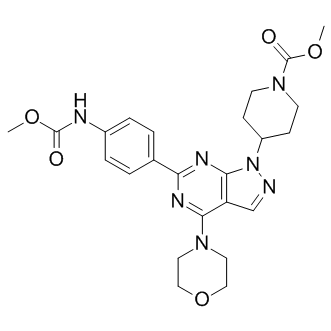| Cas No.: | 1062169-56-5 |
| Chemical Name: | 4-[6-[4-[(methoxycarbonyl)amino]phenyl]-4-(4-morpholinyl)-1H-pyrazolo[3,4-d]pyrimidin-1-yl]-methyl ester-1-piperidinecarboxylic acid |
| SMILES: | COC(NC1=CC=C(C2N=C3N(C4CCN(C(OC)=O)CC4)N=CC3=C(N3CCOCC3)N=2)C=C1)=O |
| Formula: | C24H29N7O5 |
| M.Wt: | 495.5 |
| Purity: | >98% |
| Sotrage: | 2 years -20°C Powder, 2 weeks 4°C in DMSO, 6 months -80°C in DMSO |
| Publication: | [1]. Yu K et al. Biochemical, cellular, and in vivo activity of novel ATP-competitive and selective inhibitors of the mammalian target of rapamycin. Cancer Res. 2009 Aug 1;69(15):6232-40. [2]. Weber H, et al. Rapamycin and WYE-354 suppress human gallbladder cancer xenografts in mice. Oncotarget. 2015 Oct 13;6(31):31877-88. [3]. Lijun Wang, et al. Autophagy inhibition sensitizes WYE-354-induced anti-colon cancer activity in vitro and in vivo. Tumour Biol. 2016 Sep;37(9):11743-11752. |
| Description: | WYE-354 is an ATP-competitive mTOR inhibitor with an IC50 of 5 nM. WYE-354 also inhibits PI3Kα and PI3Kγ with IC50s of 1.89 μM and 7.37 μM, respectively. WYE-354 inhibits both mTORC1 and mTORC2. |
| Target: | mTOR:5 nM (IC50) mTORC1 mTORC2 PI3K alpha:1.89 μM (IC50) PI3K gamma:7.37 μM (IC50) Autophagy |
| In Vivo: | The effect of Rapamycin and WYE-354 on tumor growth is evaluated in xenograft GBC tumor models. 2×106 or 5×106 cells of G-415 or TGBC2TKB, respectively, are xenotransplanted into NOD-SCID mice subcutaneously. When tumors reach an average volume of 100 mm3, the mice are treated either with Rapamycin or WYE354. Rapamycin is administered i.p. at a concentration of 10 mg/kg, daily for 5 days per week for 3 weeks, while WYE-354 is administrated at a daily i.p. dose of 50 mg/kg for 5 days. Mice are sacrificed 30 days after the initiation of the treatments and an autopsy is performed that include removal of the entire tumor area. Mice treated with WYE-354 exhibit 68.6% and 52.4% reduction in average tumor size (P<0.01; P<0.01), as well as 82.9% and 45.5% (P<0.01; ns) reduction in tumor weight, respectively[2]. |
| In Vitro: | In the DELFIA measuring His6-S6K1 T389 phosphorylation, WYE-354 inhibits recombinant mTOR enzyme with an IC50 of 5 nM[1]. Cell viability is analyzed by MTS assay. G-415 and TGBC-2TKB cell lines are treated with increasing concentrations of WYE-354 (0.1, 1, 5 and 10 μM) for 24, 48, and 72 hours. WYE-354 significantly reduces cell viability starting at a 1 μM concentration after a 24 hours exposure, in both studied cell lines (P<0.001). A decrease in cell viability is not observed at a dose of 100 nM, except for the TGBC-2TKB cell line after 72 hours of treatment[2]. |
| Kinase Assay: | The routine inhibitor assays are performed in 96-well plates for 2 h at room temperature in 25 μL containing 6 nM Flag-TOR(3.5) (estimated 5-10% purity), 1 μM His6-S6K and 100 μM ATP. The assays are performed and detected by DELFIA employing the Euphospho-p70S6K T389 antibody. Some assays employ a commercially purchased batch of mTOR. For inhibitor versus ATP matrix competition, mTOR kinase reactions are carried out with varying concentrations of ATP (0, 25, 50 100, 200, 400 and 800 μM) in combination with varying concentrations of inhibitor. The assays contain 12 nM Flag-TOR(3.5), 1 μM His-S6K and are incubated for 30 min. The assay results are similarly detected by DELFIA and processed for generation of double-reciprocal plots[1]. |
| Cell Assay: | G-415 and TGBC-2TKB cell lines are plated onto 96 well plates at a density of 2×103 cells per well. After an overnight attachment period cells are treated with WYE-354. The number of viable cells is determined at certain intervals using CellTiter 96 Aqueous One Solution Cell Proliferation assay. 20 μL CellTiter 96 solution is added to each well and the plates are incubated for 2 hour after which the absorbance of each well is read at a wavelength of 490 nm using a multiwell plate reader. All assays are performed in quintuplicate, and each assay is repeated three times[2]. |
| Animal Administration: | Mice[2] 8 to 12-week- old NOD-SCID mice are subcutaneously injected in one flank with either 2×106 or 5×106 cells of G-415 or TGBC2TKB, respectively, and re-suspended in 200 μL of PBS with 30% of Matrigel. When the average tumor reach 100 mm3, mice are randomly separated into four groups and treated with Rapamycin or WYE-354 and its respective vehicles. Rapamycin is administered at a daily intraperitoneal (i.p) dose of 10 mg/kg for 5 days per week for 3 weeks, while WYE-354 is administrated at a daily i.p dose of 50 mg/kg for 5 days. Tumor volumes are estimated twice a week. |
| References: | [1]. Yu K et al. Biochemical, cellular, and in vivo activity of novel ATP-competitive and selective inhibitors of the mammalian target of rapamycin. Cancer Res. 2009 Aug 1;69(15):6232-40. [2]. Weber H, et al. Rapamycin and WYE-354 suppress human gallbladder cancer xenografts in mice. Oncotarget. 2015 Oct 13;6(31):31877-88. |

 To enhance service speed and avoid tariff delays, we've opened a US warehouse. All US orders ship directly from our US facility.
To enhance service speed and avoid tariff delays, we've opened a US warehouse. All US orders ship directly from our US facility.




















